Mystery of the Great Pyramid of Giza
A Timeless Wonder

Symbolic construction of all Egyptian civilization power, the Great Pyramid of Giza (or simply Pyramid of Khufu or Cheops) is the only one of the Seven Wonders of the Ancient World that has managed to resist the ravages of time and that it is still possible to admire to this day. Erected by the second pharaoh of the fourth dynasty, the Pyramid of Khufu was to serve as a place of eternal rest and allow the soul of its sovereign to rise to the heavens and rejoin the gods.
Egyptian pyramids secrets
The Giza Plateau was the ideal location for such a project as it was spared by the flood of the Nile but at the same time was located at a reasonable distance as to allow the huge blocks to be transported by sea. The Great Pyramid of Giza and its two little sisters, that of Khafra and Menkaure, still hide to this day a large number of secrets which feeds the interest of Egyptologists from all over the world. The mystery of the pyramids and that of the Great Sphinx is at the heart of the most passionate of Ancient Egypt.
Great Pyramid mysteries
One particularly wonders if the Pyramid of Khufu really had a funerary vocation as well as how Egyptians built such a monumental construction when they didn't even know the wheel and even less so iron. Moreover, attribution to Pharaoh Khufu is problematic since it's only based on a small statuette found inside the pyramid, now preserved at the Museum of Egyptian Antiquity in Cairo, and on a single inscription found in one of the weight-relieving chambers located above the King's Chamber.
History of the Fourth Dynasty Pyramids
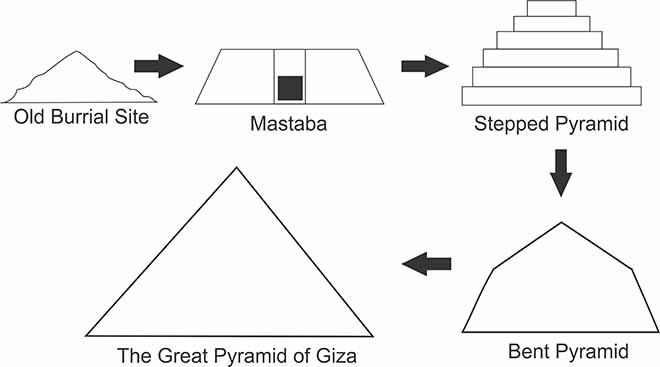
The Pyramids of Giza were preceded by those of Sneferu, the first king of the Fourth Dynasty. Father of Khufu, he built several pyramids including the Bent Pyramid in Dahshur. The constructions of Sneferu are themselves inspired by the step pyramid lying on the Saqqara plateau. Constructed by Imhotep and designed according to the giant staircase model, it served as a burial place for Pharaoh Djoser, first emperor of the Third Dynasty and pioneer of the Old Kingdom. The steps symbolized the rise of the king towards the sky.
The Pyramid of Khufu, which has 4 smooth faces, is the final stage of Egyptian pyramids evolution which began as simple mastabas serving as tombs to the pharaohs of the first two dynasties and ended with the wonders of the Giza Plateau. Its construction was followed in chronological and size order by that of the Pyramid of Khafra, himself son of Khufu, and then by the Pyramid of Menkaure, son of Khafra and the smallest of the three pyramids of Giza.
Great Pyramid construction
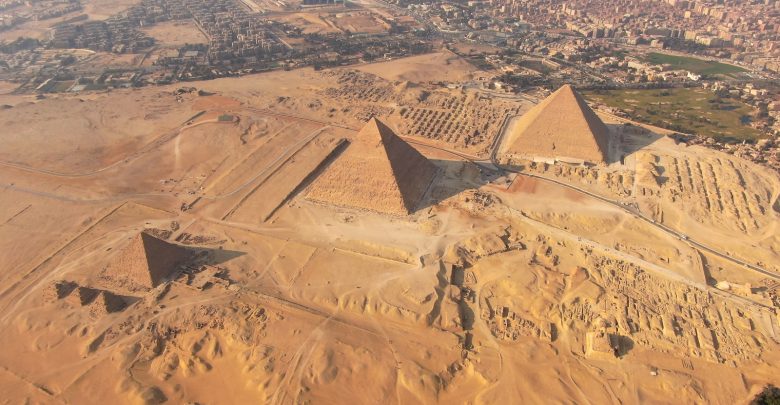
A question that often comes up when speaking about the pyramids of Giza is how were they built? Current theory is that a large part of the blocks that make up the Pyramid of Khufu were cut on the Giza Plateau thanks to a technique whose simplicity is disconcerting. Pieces of wood are slid into the cracks of limestone blocks and then soaked with water. The wet wood swells and the rock breaks off the plateau. Stone blocks, usually weighing several tons, must then be transported to the bottom of the pyramid by several mens using ropes and sledges to perform the task. Other blocks, mainly those used to finalize the sides of the pyramid, are made of white limestone and routed on the Nile from the Aswan and Troy quarries.
Different brick ramps were subsequently used to raise the blocks from the ground up to the vertiginous height of 150 meters which the Pyramid of Khufu reached at the end of its construction. Egyptians would have used three types of ramps to carry out the project: the spiral ramp, the frontal ramp and the helical ramp.

It is estimated that more than 2,000,000 large blocks were needed for the construction of the Great Pyramid of Giza, which could roughly be used to pave a very wide highway connecting the American city of New York to that of San Francisco. The Pyramid of Khufu is so colossal that it would in theory be possible to insert two and perhaps even three great Gothic cathedrals inside.
According to some sources, the construction site would've been permanently occupied by about 5,000 workers, mostly tailors and architects, but would have welcomed no less than 30,000 during the flood of the Nile. Farmers who were unable to practice agriculture were paid to transport blocks through the unbearable heat of the Sahara. There are reports that the Pharaoh would've partly financed the Great Pyramid of Giza project through invasions in Nubia and Libya where he would've exploited mines; if one believes rumors, Khufu would've also brought back countless slaves during his raids. It is even said that he would've prostituted his own daughter when he ran out of money to complete his ambitious project.
Why was the Great Pyramid built ?
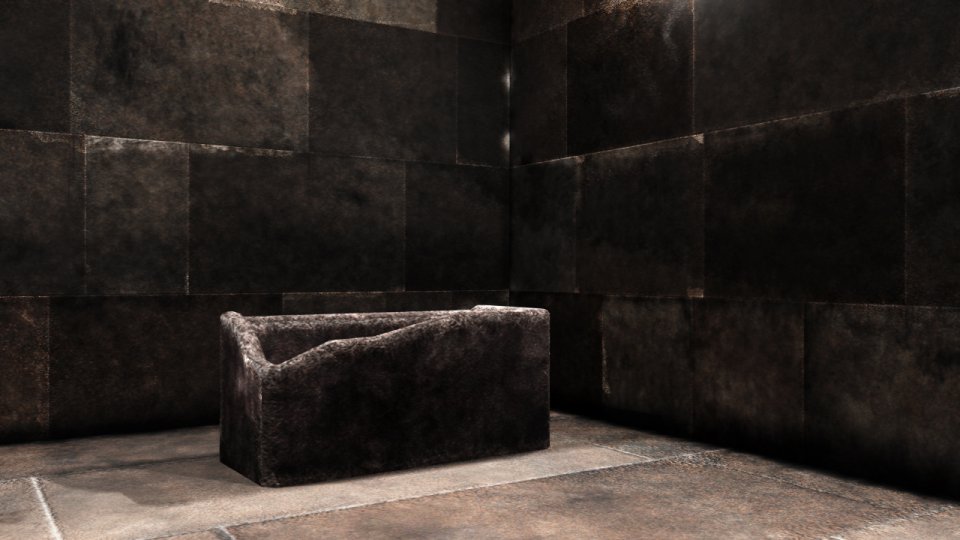
There are many theories as to the utility of the Pyramid of Khufu, the first and most common being that of the funeral complex. The King's Room, the main room of the pyramid, contained a huge sarcophagus carved in red granite when discovered. Walls were devoid of any paintings or inscriptions possibly suggesting deception.
So have appeared as many hypotheses as there are Egyptologists out there: observatory, wheat storing attic, Noah's ark landmark, very large library and even portal to another universe for the most wacky of esoterics. Believers claim that the red sarcophagus is nothing more than the Ark of the Covenant used by Moses to carry the Ten Commandments through the Sinai desert.
Inside the Great Pyramid
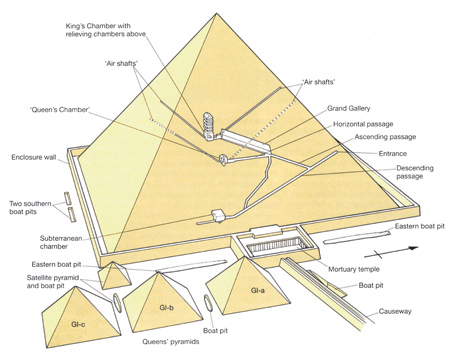
At the beginning of the ninth century, more precisely in 820, a Caliph named Abdullah al-Mamun managed to find the presumed entry of the Pyramid of Khufu which had been sealed by the Pharaoh's workers with huge blocks. The al-Mamun entrance leads directly to two passages; a descending one that leads to an underground chamber and another to climb to the top of the pyramid. The ascending passage leads to an intermediate chamber, the Queen's Chamber, and to the Grand Gallery which leads straight to the King's Chamber at 42 meters above ground. All In all, the Pyramid of Khufu only has 3 main chambers and 5 weight-relieving chambers located directly above the King's Chamber and their only function is to support the immense weight of the structure.
The usefulness of the Underground Chamber and of the Queen's Chamber which both contained absolutely nothing are unknown but it is suspected that they were intended to deceive grave robbers.
Great Pyramid air shafts
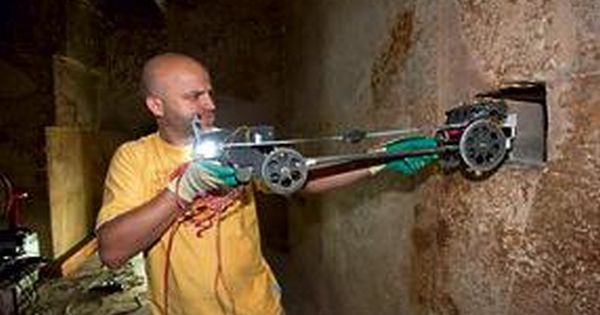
In the King's and the Queen's Chambers were found two small openings, air shafts according to some, which together form one of the secrets surrounding the construction of the Great Pyramid of Giza. Aided by tiny cameras and robots like the $250,000 Pyramid Rover, researchers managed to explore some of these conduits but still have not found anything of interest. As far as we know, if the Pyramid of Cheops did indeed have a funerary vocation, shafts were to allow the soul of the pharaoh to rise to the gods but also to return to his body.
Great Pyramid mathematical secrets
It is a well known fact that Egyptians already possessed rudimentary mathematics knowledge at that time. An astronomer, Charles Piazzi, and his friend, John Taylor, took interest in the proportions of the Great Pyramid of Giza and discovered fascinating things. If one adds the length of the four sides of the pyramid and divides the sum by its height multiplied by 2, then one obtains Pi (3,14). More surprising still, if one divides the base' surface by the lateral surface or the lateral surface by the total surface, one obtains the golden ratio (1.618). What other mysteries still hide the Giza plateau and its pyramids?









































































































































































































































































































































